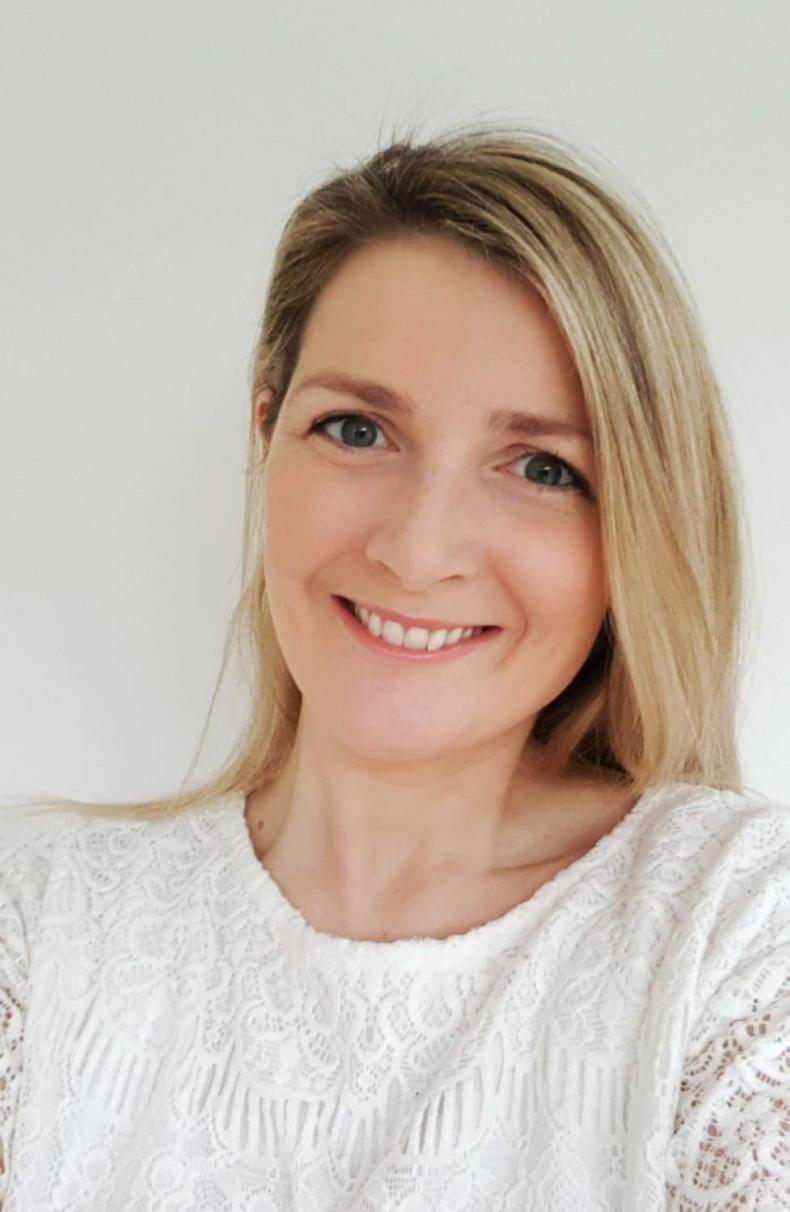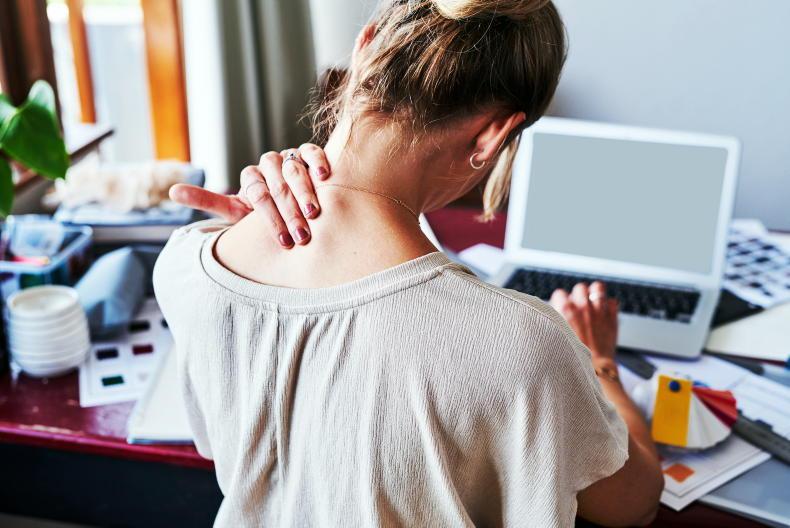Margaret Deasy puts farming-related neck and shoulder pain into two categories: trauma and non-trauma (ie, what occurs because of injury and what develops gradually over time).
Margaret is a chartered physiotherapist specialising in musculoskeletal issues and works with neurosurgeon Mr Michael Kelleher.
She is based in the Mater Private Hospital and the Sports Surgery Clinic in Santry.
“Those with trauma may present to their doctor or emergency department first.
“For farmers, the leading type of trauma is a blow from an animal – and agri workers are twice as likely to present with injuries as people in other sectors,” she says.
“A 2010 study, for example, showed that 25% of farmers suffer with neck and shoulder injury with the biggest risk factor being working with animals. When it comes to these types of injuries you could be talking about fractures, dislocated shoulders or rotator cuff tears. Whereas with non-traumatic gradual onset (of pain) experienced in the neck or shoulders, it is usually the result of sudden overuse of particular muscles. People in lots of different industries (such as office workers and construction workers) present with this kind of neck and shoulder pain, also.”

Margaret Deasy is a chartered physiotherapist specialising in musculoskeletal issues.
Power hosing, piking silage or heavy manual handling can be a frequent cause of shoulder pain among farmers, she says.
“A sudden increase in doing these kinds of tasks (which are sometimes only done at a specific time of year) may lead to a farmer experiencing pain. Working overhead for long periods when not used to it can lead to pain also.
“A sudden increase in overhead work can be typical of a farmer presenting with shoulder pain.”
Margaret’s advice is to take these tasks in stages. Take breaks to do other jobs then go back to that task again.
Why farmers are more at risk
There are several reasons why farmers present regularly with such pain, Margaret says.
“As well as a sudden increase in movements you are not used to, there are other risk factors at play for farmers also. One is that they work longer hours; often going back out to work in the evenings and at night when other members of the workforce stop. They also don’t retire at the usual retirement age.
“With increasing age comes the increasing risk of injury. We all lose muscle after the age of 25 so by the age of 65 that’s going to be significantly reduced.”
Her advice? Staying physically strong in later life is a way of reducing the risk factors listed above.
Overlap between neck & shoulder pain
There is a big crossover between neck and shoulder pain, Margaret says.
“A lot of the time the shoulder can be the culprit for neck pain so we may need to address the shoulder in rehabilitation too.
“There is an inter connection of muscles from your shoulder blade, your scapula, to your neck. These muscles help stabilise the shoulder as you use it and directly attach to the neck.
“When those muscles are not strong enough for the task at hand, an overload of that area can happen and either the rotator cuff tendon, or the neck and shoulder joints can get achy.”
Neck disc injury can cause pain in arm
Sometimes you can get a disc or joint injury to the neck, which can cause referred symptoms down the arm and into the hand. This may present as pain or cause pins and needles and numbness (neural symptoms).
Margaret’s advice, in this case, is that an MRI is required if the physiotherapist or the GP finds that there is compromise to the nerve.
Most common shoulder injury
In the shoulder itself, one of the most common injuries is called rotator cuff tendinopathy. The rotator cuff is a group of tendons and muscles that surround the shoulder joint. It is not entirely understood how a rotator cuff tendinopathy occurs, but it is thought to be an overload injury where the balance of how much the rotator cuff can do is outweighed by what it is being asked to do.
“The job of the rotator cuff (muscle) is to stabilise the shoulder as it moves. It almost ‘hugs’ the shoulder into the joint but when that muscle group isn’t up to the task, the rotator cuff tendon can become overloaded and get quite achy due to excessive forces and result in pain, weakness and impaired function. It can also cause pain in the upper arm not extending below the elbow.”
Margaret’s advice, in this case, is treatment through exercise-based physio. She points out that, in the past, massage would have been commonly used to treat rotator cuff tendinopathy.
“We are moving away from that approach now, realising that, actually, that’s not going to change the long-term outlook. We now focus on an exercise programme to help people build up their muscles so that they will be able to do the tasks that are coming their way every day without excessive forces on the tendon. Massage can give short-term relief which the patient may also need but the emphasis is on rehabilitation.”
Exercises
Farmers need to stay physically strong to ready themselves for tasks, she adds.
“Because of the high demands on farmers we have to rehabilitate them after injury to a high capacity. While stretching exercises do help we actually need to push the person through resistance band exercises as well as hand weight exercises also to get them quite strong. The ideal would be that if it (the injury/pain) happens again then the person knows know how to self-manage it.”
Margaret’s advice, in this case, is that education is key when it comes to treatment – learning the exercises in order to self-manage if it occurs again or prevent it happening by having strong muscles. Exercises can help stave off injury by increasing mobility and strength.
Tip
Instead of doing three full days of one activity, split your day. Do other tasks in the afternoon so that you don’t overload. Stay physically strong to ensure that your body has the capacity for the task at hand.
Worry can make it worse
Worry and stress about your injury can heighten the pain, she points out.
“Worry can go along with a lot of injuries. People worry that they are not going to be able to do their job, they hear medical jargon they don’t understand and they think it’s going to be long-term problem or that they will never recover and always have pain. That worry and stress, if left unchallenged, can actually worsen your outcome,” she says.
“An alternative approach is to think, ‘This is just as a result of something I recently did. I know that once I have relative* rest and change my activities for a couple of days and start back with the exercise programme that I got in the past or that I’ve just been shown and slowly try to build that up again that I will get better.’”
*Relative rest means not stopping everything but easing off the activities that really aggravate the pain.
Getting exercise right
Margaret recognises that it is important to get the exercise level right.
“It is about finding the right starting point that allows a person to exercise comfortably and get relief from the programme. We have to educate the patients about what the programme should feel like and when they should do their exercises. Strengthening exercises don’t have to be done every day when they are the right type. Three times a week is enough to build strength. You will need those rest days so you can fatigue the muscles during the exercises then let them recover.”
She points out that there are three stages of rehabilitation – early, mid and late.
“The early load needs to be within the person’s capacity, whether you’re talking about tissues, tendons or joints. You have to find a way to challenge it without making it more painful. As that tolerance level lifts you, then up the exercises a bit and so on.”
MRI: when is one needed?
If there is a loss of sensation and power in your arms or signs like changes to balance or dexterity in your hands or a long history of pain an MRI will be recommended.
“If there is continued pain or weakness in the shoulder you definitely need to follow up. If you have had a trauma (an injury) you will need an X-ray or MRI. A lot of rotator cuff tears can be fixed through exercise but some will warrant early surgery. Even a big tear can be treated with exercise but with younger farmers, an early surgery can sometimes be better if there is a lot of weakness.”
MRIs explained
She points out that MRI results have to be explained carefully because much of what shows up on the scan could just be normal changes.
“We know that 50% of people over the age of 30 will have changes on their spinal MRI scan without experiencing pain and that 80% of people over 60 will have changes on their spinal MRI scan without experiencing pain. These changes are considered like wrinkles of the skin or greying of the hair.
“We have to ensure that the MRI results correspond to the patient’s symptoms and carefully explain to the patient what is relevant and what is not. It is important that the patient fully understands their MRI results.”
Surgery
Helping patients avoid surgery is an important role for a physiotherapist, she adds.
“Surgeons often offer a patient a trial of conservative management involving exercise and injections first. Less than 10% of cases that we see require surgery. Nerve root or steroid injections often give patients a window of opportunity to get a rehabilitation programme underway. Steroidal injections can have negatives effects too and so in some cases they aren’t offered but a course of physiotherapy in the form of rehabilitative exercise instead.”
Read more
The most common rare disease you’ve never heard of
Type 1 diabetes: pass the TEST
Margaret Deasy puts farming-related neck and shoulder pain into two categories: trauma and non-trauma (ie, what occurs because of injury and what develops gradually over time).
Margaret is a chartered physiotherapist specialising in musculoskeletal issues and works with neurosurgeon Mr Michael Kelleher.
She is based in the Mater Private Hospital and the Sports Surgery Clinic in Santry.
“Those with trauma may present to their doctor or emergency department first.
“For farmers, the leading type of trauma is a blow from an animal – and agri workers are twice as likely to present with injuries as people in other sectors,” she says.
“A 2010 study, for example, showed that 25% of farmers suffer with neck and shoulder injury with the biggest risk factor being working with animals. When it comes to these types of injuries you could be talking about fractures, dislocated shoulders or rotator cuff tears. Whereas with non-traumatic gradual onset (of pain) experienced in the neck or shoulders, it is usually the result of sudden overuse of particular muscles. People in lots of different industries (such as office workers and construction workers) present with this kind of neck and shoulder pain, also.”

Margaret Deasy is a chartered physiotherapist specialising in musculoskeletal issues.
Power hosing, piking silage or heavy manual handling can be a frequent cause of shoulder pain among farmers, she says.
“A sudden increase in doing these kinds of tasks (which are sometimes only done at a specific time of year) may lead to a farmer experiencing pain. Working overhead for long periods when not used to it can lead to pain also.
“A sudden increase in overhead work can be typical of a farmer presenting with shoulder pain.”
Margaret’s advice is to take these tasks in stages. Take breaks to do other jobs then go back to that task again.
Why farmers are more at risk
There are several reasons why farmers present regularly with such pain, Margaret says.
“As well as a sudden increase in movements you are not used to, there are other risk factors at play for farmers also. One is that they work longer hours; often going back out to work in the evenings and at night when other members of the workforce stop. They also don’t retire at the usual retirement age.
“With increasing age comes the increasing risk of injury. We all lose muscle after the age of 25 so by the age of 65 that’s going to be significantly reduced.”
Her advice? Staying physically strong in later life is a way of reducing the risk factors listed above.
Overlap between neck & shoulder pain
There is a big crossover between neck and shoulder pain, Margaret says.
“A lot of the time the shoulder can be the culprit for neck pain so we may need to address the shoulder in rehabilitation too.
“There is an inter connection of muscles from your shoulder blade, your scapula, to your neck. These muscles help stabilise the shoulder as you use it and directly attach to the neck.
“When those muscles are not strong enough for the task at hand, an overload of that area can happen and either the rotator cuff tendon, or the neck and shoulder joints can get achy.”
Neck disc injury can cause pain in arm
Sometimes you can get a disc or joint injury to the neck, which can cause referred symptoms down the arm and into the hand. This may present as pain or cause pins and needles and numbness (neural symptoms).
Margaret’s advice, in this case, is that an MRI is required if the physiotherapist or the GP finds that there is compromise to the nerve.
Most common shoulder injury
In the shoulder itself, one of the most common injuries is called rotator cuff tendinopathy. The rotator cuff is a group of tendons and muscles that surround the shoulder joint. It is not entirely understood how a rotator cuff tendinopathy occurs, but it is thought to be an overload injury where the balance of how much the rotator cuff can do is outweighed by what it is being asked to do.
“The job of the rotator cuff (muscle) is to stabilise the shoulder as it moves. It almost ‘hugs’ the shoulder into the joint but when that muscle group isn’t up to the task, the rotator cuff tendon can become overloaded and get quite achy due to excessive forces and result in pain, weakness and impaired function. It can also cause pain in the upper arm not extending below the elbow.”
Margaret’s advice, in this case, is treatment through exercise-based physio. She points out that, in the past, massage would have been commonly used to treat rotator cuff tendinopathy.
“We are moving away from that approach now, realising that, actually, that’s not going to change the long-term outlook. We now focus on an exercise programme to help people build up their muscles so that they will be able to do the tasks that are coming their way every day without excessive forces on the tendon. Massage can give short-term relief which the patient may also need but the emphasis is on rehabilitation.”
Exercises
Farmers need to stay physically strong to ready themselves for tasks, she adds.
“Because of the high demands on farmers we have to rehabilitate them after injury to a high capacity. While stretching exercises do help we actually need to push the person through resistance band exercises as well as hand weight exercises also to get them quite strong. The ideal would be that if it (the injury/pain) happens again then the person knows know how to self-manage it.”
Margaret’s advice, in this case, is that education is key when it comes to treatment – learning the exercises in order to self-manage if it occurs again or prevent it happening by having strong muscles. Exercises can help stave off injury by increasing mobility and strength.
Tip
Instead of doing three full days of one activity, split your day. Do other tasks in the afternoon so that you don’t overload. Stay physically strong to ensure that your body has the capacity for the task at hand.
Worry can make it worse
Worry and stress about your injury can heighten the pain, she points out.
“Worry can go along with a lot of injuries. People worry that they are not going to be able to do their job, they hear medical jargon they don’t understand and they think it’s going to be long-term problem or that they will never recover and always have pain. That worry and stress, if left unchallenged, can actually worsen your outcome,” she says.
“An alternative approach is to think, ‘This is just as a result of something I recently did. I know that once I have relative* rest and change my activities for a couple of days and start back with the exercise programme that I got in the past or that I’ve just been shown and slowly try to build that up again that I will get better.’”
*Relative rest means not stopping everything but easing off the activities that really aggravate the pain.
Getting exercise right
Margaret recognises that it is important to get the exercise level right.
“It is about finding the right starting point that allows a person to exercise comfortably and get relief from the programme. We have to educate the patients about what the programme should feel like and when they should do their exercises. Strengthening exercises don’t have to be done every day when they are the right type. Three times a week is enough to build strength. You will need those rest days so you can fatigue the muscles during the exercises then let them recover.”
She points out that there are three stages of rehabilitation – early, mid and late.
“The early load needs to be within the person’s capacity, whether you’re talking about tissues, tendons or joints. You have to find a way to challenge it without making it more painful. As that tolerance level lifts you, then up the exercises a bit and so on.”
MRI: when is one needed?
If there is a loss of sensation and power in your arms or signs like changes to balance or dexterity in your hands or a long history of pain an MRI will be recommended.
“If there is continued pain or weakness in the shoulder you definitely need to follow up. If you have had a trauma (an injury) you will need an X-ray or MRI. A lot of rotator cuff tears can be fixed through exercise but some will warrant early surgery. Even a big tear can be treated with exercise but with younger farmers, an early surgery can sometimes be better if there is a lot of weakness.”
MRIs explained
She points out that MRI results have to be explained carefully because much of what shows up on the scan could just be normal changes.
“We know that 50% of people over the age of 30 will have changes on their spinal MRI scan without experiencing pain and that 80% of people over 60 will have changes on their spinal MRI scan without experiencing pain. These changes are considered like wrinkles of the skin or greying of the hair.
“We have to ensure that the MRI results correspond to the patient’s symptoms and carefully explain to the patient what is relevant and what is not. It is important that the patient fully understands their MRI results.”
Surgery
Helping patients avoid surgery is an important role for a physiotherapist, she adds.
“Surgeons often offer a patient a trial of conservative management involving exercise and injections first. Less than 10% of cases that we see require surgery. Nerve root or steroid injections often give patients a window of opportunity to get a rehabilitation programme underway. Steroidal injections can have negatives effects too and so in some cases they aren’t offered but a course of physiotherapy in the form of rehabilitative exercise instead.”
Read more
The most common rare disease you’ve never heard of
Type 1 diabetes: pass the TEST










SHARING OPTIONS